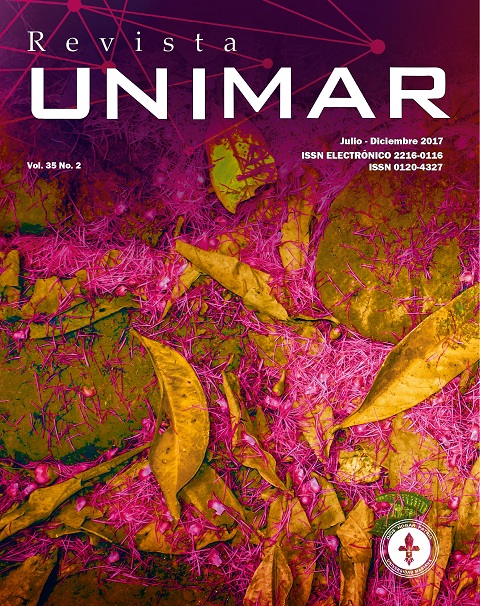Analysis of physicochemical parameters in a biological reactor in the treatment of leached sludge from Doña Juana Sanitary Landfill
Keywords:
Landfill, leached sludge, activated sludge, prolonged aeration and environmental impactsAbstract
Landfills are designed so that the least possible amount of environmental impacts can develop within their operation; however, a disproportionate increase in waste results in an increase in the production of leachates, compounds disposed in appropriate treatment plants. As a result of this process, a waste known as ‘leachate sludge’ is generated. In the case of the Doña Juana Landfill (RSDJ), in Bogota, Colombia, an average of 6,300 t / day of waste are received; 20.6 L / s of leachate are treated and 600 t / day of leachate sludge are produced, stored without any type of treatment.
This research sought to establish the efficiency of sludge treatment by means of a pilot biological reactor of the ‘Activated Sludge System’, supplemented with prolonged aeration, in order to reduce the pollutant load values. Finally, a removal efficiency greater than 80% was obtained in the parameters evaluated by the pilot system, and it must be taken into account, in the case of the RSDJ, to comply with the current environmental regulations (Resolution 0631 of 2015), which is regulated on the basis of the concentration of pollutants and not in relation to removal efficiency.
Author Biographies
Álvaro Chávez Porras, Universidad Militar Nueva Granada
Ingeniero Industrial, Ph.D., Profesor Asistente, Líder Grupo PIT, Facultad de Ingeniería, Universidad Militar Nueva Granada, Cajicá, Cundinamarca, Colombia.
Luis Felipe Pinzón Uribe, Universidad Militar Nueva Granada
Ingeniero Geógrafo, Ph.D., Profesor Asociado, Investigador Grupo PIT, Facultad de Ingeniería, Universidad Militar Nueva Granada, Bogotá D.C., Colombia.
Nicolás Casallas Ortega, Universidad Militar Nueva Granada
Ingeniero Ambiental, Esp., Asistente de Investigación Facultad de Ingeniería, Universidad Militar Nueva Granada. Bogotá D.C., Colombia.
References
Avendaño, E. (2015). Panorama actual de la situación mundial, nacional y distrital de los residuos sólidos. Análisis del caso Bogotá, D.C. Programa ‘Basura Cero’.(Trabajo de grado). Recuperado de http://repository.unad.edu.co/bitstream/10596/3417/1/79911240.pdf
Arrieta, M. (2008). Adecuación final y clausura de rellenos sanitarios. (Trabajo de Grado). Recuperado de repositorio.unisucre.edu.co/bitstream/001/302/2/628.44564A775.pdf
Departamento Nacional de Planeación. (DNP). (2016). Rellenos sanitarios de 321 municipios colapsarán en cinco años, advierte el DNP. Recuperado de https://www.dnp.gov.co/Paginas/Rellenos-sanitarios-de-321-municipios-colapsar%C3%A1n-en-cinco-a%C3%B1os,-advierte-el-DNP--.aspx
Duarte, C. (Coord.). (2006). Cambio global: Impacto de la actividad humana sobre el sistema Tierra. Madrid, España: Consejo Superior de Investigaciones Científicas (CSIC).
Guo, J., Peng, Y., Wang, S., Zheng, Y., Huang, H. & Ge, S. (2009). Effective and robust partial nitrification to nitrite by real-time aereation duration control in an SBR treating domestic wastewater. Process Biochemistry 44(9), 979-985. https://doi.org/10.1016/j.procbio.2009.04.022
Guo, W., Yang, S., Xiang, W., Wang, X. & Ren, N. (2013). Minimization of excess sludge production by in-situ activated sludge treatment processes. A comprehensive review. Recuperado de http://europepmc.org/abstract/MED/23792182
Henry, G. y Heinke, G. (1999). Ingenieria Ambiental (2ª.ed.). México: Pearson Educación.
Jaramillo, J. (2002). Guía para el diseño, construcción y operación de rellenos sanitarios manuales. Una solución para la disposición final de residuos sólidos municipales en pequeñas poblaciones. Medellín, Colombia: Centro Panamericano de Ingeniería Sanitaria y Ciencias del Ambiente, División de Salud y Ambiente, Organización Panamericana de la Salud, Oficina Sanitaria Panamericana, Oficina Regional de la Organización Mundial de la Salud.
Lee, I., Lim, H., Hung, B., Colosimo, M. & Kim, H. (2014). Evaluation of aeration energy saving in two modified activated sludgeprocesses. Recuperado de http://europepmc.org/abstract/med/24784771
Ministerio de Ambiente y Desarrollo Sostenible. (2015). Resolución 0631 “por la cual se establece los parámetros y los valores límites máximos permisibles en los vertimientos puntuales a cuerpos de agua superficiales y a los sistemas de alcantarillado público y se dicta otras disposiciones”. Bogotá, Colombia. Recuperado de http://www.minambiente.gov.co/images/normativa/app/resoluciones/d1-res_631_marz_2015.pdf
Ministerio del Medio Ambiente. (2002). Guía ambiental para rellenos sanitarios. Bogotá, Colombia: El Ministerio.
Morales, C. (2007). Estudio para la remoción de metales pesados en los lixiviados de rellenos sanitarios. (Trabajo de grado). Universidad Nacional de Colombia, Sede Manizalez. Recuperado de http://www.bdigital.unal.edu.co/1073/1/claudiajohanamorales.2007.pdf
Ramalho, R. (2016). Tratamiento de aguas residuales. Quebec, Canada: By Priale.
Ratkovich, N., Horn, W., Helmus, F., Rosenberger, S., Naessens, W., Nopens, I. & Bentzen, T. (2012). Activated sludge rheology: a critical review on data collection and modelling. Recuperado de http://europepmc.org/abstract/med/23219387
Standart Methods for the examination of water and wastewater (22nd ed.). (s.f.). Recuperado de https://beta-static.fishersci.com/content/dam/fishersci/en_US/documents/programs/scientific/technical-documents/white-papers/apha-water-testing-standard-methods-white-paper.pdf
Tyagi, V., Subramaniyan, S., Kazmi, A. & Chopra, A. (2008). Microbial community in conventional and extended aeration activated sludge in plants in India. Ecological Indicators, 8(5), 550-554. https://doi.org/10.1016/j.ecolind.2007.07.002
Urrea, J., Collado, S., Laca, A. & Díaz, M. (2014). Wet oxidation of activated sludge: Transformations and mechanisms. Journal of Environmental Management, 146, 251-259. https://doi.org/10.1016/j.jenvman.2014.07.043
How to Cite
Downloads
Downloads
Published
Issue
Section
License

This work is licensed under a Creative Commons Attribution 4.0 International License.
Los autores que publiquen en esta revista aceptan las siguientes condiciones:
1. Los autores conservan los derechos de autor y ceden a la revista el derecho de la primera publicación, con el trabajo registrado con la licencia de atribución de Creative Commons, que permite a terceros utilizar lo publicado siempre que mencionen la autoría del trabajo y a la primera publicación en esta revista.
2. Los autores pueden realizar otros acuerdos contractuales independientes y adicionales para la distribución no exclusiva de la versión del artículo publicado en esta revista (p. ej., incluirlo en un repositorio institucional o publicarlo en un libro) siempre que indiquen claramente que el trabajo se publicó por primera vez en esta revista.
3. Se permite y recomienda a los autores publicar su trabajo en Internet (por ejemplo en páginas institucionales o personales) antes y durante el proceso de revisión y publicación, ya que puede conducir a intercambios productivos y a una mayor y más rápida difusión del trabajo publicado (veaThe Effect of Open Access).
Altmetric
| Article metrics | |
|---|---|
| Abstract views | |
| Galley vies | |
| PDF Views | |
| HTML views | |
| Other views | |








